CyanogenMod Review
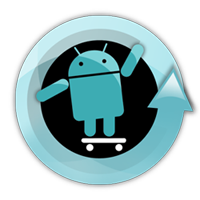 Today I will tell you a little about CyanogenMod . This is such a great firmware based on the android source code. Officially, the development goes under this list of devices here, but in fact the supported devices are much larger. And all thanks to the guys from xda-dev , who are porting the firmware to their phones.
Today I will tell you a little about CyanogenMod . This is such a great firmware based on the android source code. Officially, the development goes under this list of devices here, but in fact the supported devices are much larger. And all thanks to the guys from xda-dev , who are porting the firmware to their phones.In addition to many inconspicuous internal changes to the user, aimed at improving performance and stability, the firmware has a number of extremely convenient and useful features and settings that are missing from the original firmware and which I am going to tell about.
At the moment, the latest version is based on Gingerbread 2.3.3 CyanogenMod7 RC3, but in spite of its status, it is quite usable and suitable for everyday use. Together with the firmware you get the already installed BusyBox and ADW Launcher, received root-rights and the lack of pre-installed programs by the manufacturer. Oh yeah, there are no apps from Google yet, they need to be downloaded separately. I note that in the standard package there is Russian, so do not be intimidated by the screenshots :)
')
So what do we have?
Food menu
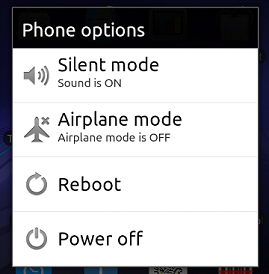
 The menu, called by holding the power button, has now acquired a new item - reboot, which allows for a reboot in three modes:
The menu, called by holding the power button, has now acquired a new item - reboot, which allows for a reboot in three modes:- Normal reboot
- Reboot into recovery mode (required for flashing various patches, running scripts, backing up the system, etc.)
- Reboot to bootloader mode (required for installing official firmware)
Native theme support
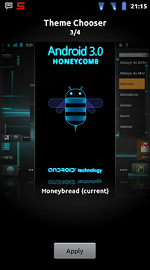 This is perhaps what is most lacking in android. Themes are installed as normal applications. They can completely change the resources of the system itself, as well as other installed applications (if not mistaken, then only those installed in / system / app or / data / app-private), including their icons.
This is perhaps what is most lacking in android. Themes are installed as normal applications. They can completely change the resources of the system itself, as well as other installed applications (if not mistaken, then only those installed in / system / app or / data / app-private), including their icons.Previously, the problem of easy installation was solved with the help of MetaMorph, now it has become even easier.
At the moment, that is not so much, but it is only a matter of time. Among all available is Honeybread .
Notification bar

The power management widget is one of the most convenient features. The idea is that you can control various functions, for example, with one touch, change 2G to 3G, switch to airplane mode, turn on the flashlight, put the device to sleep, turn off the sound, change the brightness, switch the track and the like. You can install any number of such buttons (if more than 7, then a horizontal scroll will appear) and change the order of their location.
And you can also turn on the display of the remaining charge in percent and \ or remove the clock.
Visualization profiles


This thing will be useful to owners of amoled. As you know, on displays of this type when displaying shades of dark colors consumes significantly less energy than when displaying light ones.
This feature changes the screen colors in accordance with the selected template, of which only about 10 pieces. Among them there are both absolutely hardcore options, and more or less normal, blackened.
There is also a widget for fast switching between modes.
I will say that it really works and may well save the vital battery stick. And if you get used to it, you can use it all the time.
Tweaks of the volume and camera buttons
There are three changes concerning the logic of the buttons for changing the volume and calling the camera.
If you hold the volume button for a long time, the current track will change, that is, if you hold Volume Up, the next track will start playing. And it works in almost all players and only when the screen is off.
In landscape mode, the volume buttons are swapped. If in portrait mode the volume increases the top button, then in landscape mode the bottom one (which will be on the right).
Long holding the camera button works like play / pause when the screen is off.
Of course, all this can be disabled.
DSP Manager
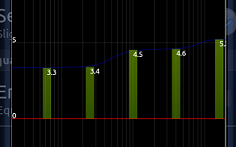
This is a global equalizer that allows you to separately adjust the sound from the headphones, from the speakers, and from the bluetooth devices. It works regardless of the player used.
You can turn on compression, reverberation, strengthen the bass, and, of course, control specific frequencies, although this is done extremely inconveniently, and there are no predefined settings.
apps2sd
Also in the firmware there is a modified apps2sd. It allows you to transfer any applications (even those that do not support transfer) to the memory card without using the ext partition. However, in this case only the application itself, that is, the apk file, will be transferred, and all the files created by it will remain in the phone’s memory.
It is also possible to transfer all applications, together with the cache and data, to a separate ext partition on the memory card. For this you can use the program simple2ext . With this transfer, the widgets will remain working, because they use symlinks.
Performance settings
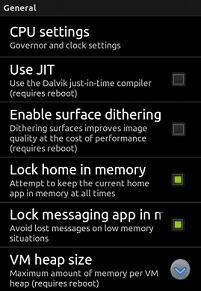
 The most remarkable feature in this menu is the ability to lock the desktop and SMS applications in memory. This means that when there is a shortage of memory, the system will not unload them. So you no longer have to wait for a good five seconds while the desktop loads after some resource-intensive application. And also there will be no problems with not reached messages during games.
The most remarkable feature in this menu is the ability to lock the desktop and SMS applications in memory. This means that when there is a shortage of memory, the system will not unload them. So you no longer have to wait for a good five seconds while the desktop loads after some resource-intensive application. And also there will be no problems with not reached messages during games.In addition, here you can configure VM heap, JIT and Surface Dithering (I did not notice any difference between on and off).
Also here you can set the minimum and maximum processor frequency (taken from /etc/init.d/10overclock) and select the overclocking profile. There are six such profiles to choose from:
- Ondemand - as soon as possible changes the frequency of the processor depending on its use. It is a standard profile in the official firmware.
- Conservative - modification of the ondemand profile. The difference lies in the fact that the frequency changes more smoothly, and does not jump up at the time of a strong load. Aims to reduce energy consumption.
- Interactive - sets the frequency of the processor depending on the load, something like conservative and ondemand does, but using delays.
- Smartass is a rewritten interactive profile. According to the developers, it works more responsively, while most of the time the device operates at low frequencies. Himself reduces the frequency during sleep.
- Userspace - allows any program running from root to change the current frequency.
- Performance - at the very minimum load increases the frequency to the set maximum.
A little more detail can be read in the documentation for the CM on github. (In English)
Power control

The standard power management widget has also changed. Now he is somewhat reminiscent of a similar Widgetsoid , only eats less.
As you can see, a rather long list of various options is offered. Among them are the attachment to events, for example, automatic activation of wi-fi or bluetooth when charging, automatic activation of 3G when the mobile Internet is turned on, automatic synchronization on when connected to wi-fi, and the like. Do not forget about the appearance: you can change the background color, rounded edges and orientation.
Lock screen
 On the lock screen, the player control buttons are now displayed. It is noteworthy that if the player is not running, then when you click on play, it starts and along with it, the prev and next appear on the sides of the button. You can add a track title and its cover.
On the lock screen, the player control buttons are now displayed. It is noteworthy that if the player is not running, then when you click on play, it starts and along with it, the prev and next appear on the sides of the button. You can add a track title and its cover.Gesture support added. At the gesture, you can attach the launch of any activation, unlocking, changing the sound mode or a flashlight. You can draw gestures yourself. It is possible to disable the display of the track and its color.
It is also possible to change the type of unlocking, the choice is given between a regular slider, a rotating slider and a bottom panel.
There are several other small buns, such as adding a third icon to launch activation or quick unlock by clicking on the menu or trackball.
But the most useful feature of Lockscreen is the ability to configure its activation timeouts. The bottom line is that you can adjust the activation time of the unlock screen, depending on why the screen turned off. For example, if you turned it off yourself, the phone will block in a second, and if you just did not touch it for a long time, then in a minute.
Sound setting
Here you can fine-tune the logic of the behavior of sound alerts, signals and ringtones separately. Change their normal volume, change the volume while playing music, make sure that alerts are always played only through the speaker, or set up “quiet hours” - automatically turn off the sounds for a certain period of time.
LED indicator setting
This section of settings will allow you to fine-tune the behavior of the luminous indicator, which is usually located above the screen.
You can turn off the blinking when the screen is turned off, make the color selection random or in order. In addition, you can adjust the color and flashing frequency for each individual application.
Phone goggles
 This is the name of the filter of unwanted calls and messages. But not from the outside, as you might think, from the side, but from the inside. You can set a list of numbers to be filtered.
This is the name of the filter of unwanted calls and messages. But not from the outside, as you might think, from the side, but from the inside. You can set a list of numbers to be filtered.There are three levels to choose from: complete ban, ban with query and ban with a mathematical problem.
In the first case, you just can’t call or send SMS.
In the second case, you will be presented with a confirmation dialog.
In the third case, you will be given a mathematical task of a light, medium or complex level.
It is possible to turn on the filter only in a certain period of time.
I think it will be useful for those who like to call someone after a stormy night, tell a crap, and execute themselves for it the next morning.
Tweaking brightness control
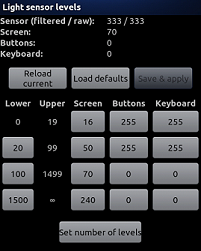
Allows you to precisely adjust the brightness levels for the screen, buttons, and keyboard, if available. Displays the current brightness level and readings from the sensor. In addition, it is possible to change the polling interval, response time, zero brightness level and some other parameters.
Camera
The camera added the ability to assign a volume rocker to the zoom, and the search button on the picture.
A pre-focus function has appeared, which focuses the camera directly in front of the image, and the long focus function, calculated, apparently, on devices with a normal camera button — when pressed, it focuses, and when released, a photo is taken.
Other Utility
- Killing the process with a long tap on the "Back" button
- Vibration fine tuning
- Reassigning actions to hold the Home button and Search button for a long time
- Set up the effect of a TV lamp separately to turn the screen off and on
- Setting the type and height of overscrolling
- The ability to turn on bluetooth in airplane mode
- FLAC support
- FM radio support for some models
- OpenVPN support
- Wi-Fi, Bluetooth and USB tethering.
- Incognito mode in standard browser
Conclusion
Thank you all for your attention. I hope at least someone, having read the article, will get acquainted with CM.
I will gladly accept any criticism.
Source: https://habr.com/ru/post/114786/
All Articles